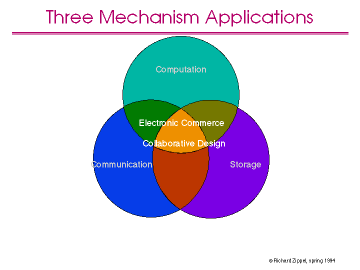
Back to the previous slide, on to the next slide or up to the overview
I believe that the next generation of applications -- those that will begin to take advantage of the revolutionary changes in computing, communications and storage hardware and will revolutionize our lives -- will be those applications that rely on all three of these mechanisms equally.
The example of such an application that is most immediately at hand is collaborative design, such as when developing a new automobile or aircraft. A number of designers will be involved in the project, scattered throughout the company and its sub-contractors. Cost and performance will be continuously optimized via simulations that predict the behavior of the design before it is fabricated. The results of the simulations, as well as the detailed part descriptions, manufacturing plans and schedules, marketing data and advertising plans are an enormous distributed database. These tools will allow the collaborative design system to identify inconsistencies and inadequencies in the design as they arise, so that they can be dealt with immediately rather than as a ``fix-up'' after manufacture. We have the standard issues of concurrency control and data storage, since several designers will be working on the design concurrently.
Basic teleconferencing systems have been available for several years. To a great extent these are expanded telephone systems that are able to handle the larger bandwidth requirements of real-time video. Enhanced teleconferencing systems will allow us to use teleconferencing to mediate meetings between several organizations scattered around the world. Image processing and vision tools will allow us to track objects of interest in the video scene, e.g. always having the speaker properly positioned in the image, along the the prop s/he is referring to. The need to record previous meetings, and to call up previous presentations in the middle of a meeting, places strong storage requirements on the system.
Richard Zippel